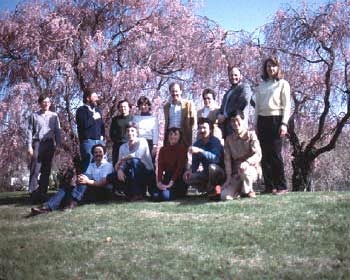A New Multi-Disciplinary Unit
At this point, Dubner decided that he needed to "pick the brain" of a leader in the field and arranged a year's sabbatical at University College London with Patrick Wall (1970-71). He returned from London to an expanded and growing Section. Rhyuji Sumino had arrived from Japan to begin several years of collaborative work; he would soon be joined by Donald Price and Jimmy Hu . NIDR was reorganizing both its intramural and its extramural programs; as part of this initiative, Ed Driscoll played a key role on the Institute's Ad Hoc Advisory Committee on Pain Control (1971-72).
The first major result of the Committee's recommendations was the creation in 1973 of a new extramural program for Pain Control and Behavioral Studies, under the leadership of Aaron Ganz . NIDR's extramural support provided crucial support for the International Symposium on Pain held in Issaquah, Washington, in May 1973, which led to the formation of the International Association for the Study of Pain and the founding of its journal, Pain.
John Bonica, organizer of the Issaquah meeting and the "godfather" of the multidisciplinary pain field, used NIDR grants to support his broad-based pain research program at the University of Washington. In a letter to Aaron Ganz in 1979, he noted that: "NIDR has the best record of supporting pain research [of all the Institutes]."1
The other major outcome of the NIDR reorganization was the formation of the Neurobiology and Anesthesiology Branch (NAB) in 1974, a new unit incorporating Ron Dubner's basic science work with a reactivated program to improve dental anesthesia and analgesia. John Bonica wrote in 1980 that the NAB had proven to be "one of the most productive groups of pain researchers in the world." 2
The remarkable productivity stems from the conjunction of these two events: the formation of a new pain research unit around the core group established by Dubner and the consensus reached at Issaquah that the study of pain required a multidisciplinary approach.
Most previous physiological research had treated pain as a problem in sensory perception, based on specific "hard-wired" nerve structures and mechanisms which could be isolated in the laboratory. The more complex model of Bonica, Wall, and Melzack described pain as a dynamic phenomenon of an organism reacting to the environment, or, as Bonica had written in 1953, "the compound result of physiopsychological processes whose complexity is almost beyond comprehension."3
Influenced by these three pioneers, Dubner visualized a program which would integrate electrophysiological and neurocytological studies of the trigeminal neural system with behavioral experiments in animals, and with clinical and psychophysical assessments of pain in human subjects.
Program for the International Symposium on Pain, Issaquah, Washington, May 1973
Aaron Ganz, Edward Driscoll, John Bonica, and Seymour Kreshover at Issaquah, 1973
John Bonica at the podium.
The Neurobiology and Anesthesiology Branch
A Multidisciplinary Research Program:
- electrophysiology
- neuroanatomy
- neurochemistry
- animal behavior
- clinical pharmacology
- psychophysics
For more information on the history of the pain field, see: "The Relief of Pain and Suffering" (an online exhibit).
For more information on the American Pain Society: www.ampainsoc.org
The Neurobiology and Anesthesiology Branch, 1979
References
- Letter from John Bonica to Aaron Ganz, from the John J. Bonica Papers, Ms. Coll. 118, John C. Liebeskind History of Pain Collection, UCLA.
- John Bonica, "Introduction," to John Bonica and Lorenz Ng, Pain, Discomfort, and Humanitarian Care (Elsevier, 1980) p. 29.
- John J. Bonica, The Management of Pain (Lea and Febiger, 1953) p. 154.





